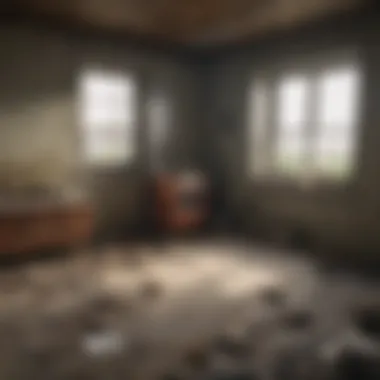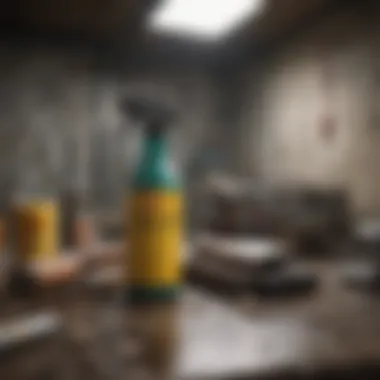Comprehensive Strategies for Effective Mold Removal


Intro
Mold infestations can bring numerous challenges to homeowners, impacting both health and structural integrity. Mold is more than just a nuisance; it can affect physical health and degrade indoor environments. This article aims to present comprehensive strategies for identifying, mitigating, and removing mold effectively. Understanding the mold lifecycle and its preferred conditions is paramount. By equipping oneself with the right knowledge, homeowners can ensure a healthier living space.
Understanding Mold
What is Mold?
Mold is a type of fungus that thrives in damp, warm environments. It reproduces through spores which can be airborne, making it easy to spread. Types of mold vary; some are relatively harmless while others can cause serious health issues.
Common Types of Mold in Homes
- Aspergillus: Often found indoors, can trigger allergies.
- Stachybotrys (black mold): Associated with severe allergic reactions and respiratory issues.
- Cladosporium: Common both indoors and outdoors, can lead to skin infections.
Knowing these types can help in identifying potential health risks.
"Mold recognition is the first step in effective management."
Key Factors for Mold Growth
Moisture
Mold requires moisture to thrive. The presence of water or humidity is a major contributing factor. Common sources include leaks, flooding, or high humidity levels.
Temperature
Mold prefers warm environments. Typically, temperatures between 77°F and 86°F (25°C and 30°C) are optimal for growth.
Nutrients
Mold can grow on various organic materials, including wood, paper, and even dust. Understanding these environments will aid in mold prevention strategies.
Comprehensive Mold Removal Strategies
Identification
Identifying mold is the first step. Look for visible growth, unusual smells, or water damage. Using tools like moisture meters can provide data about humidity levels in your home.
Assessment
Once mold is identified, an assessment should be made on the extent of the infestation. Professional services can help determine the severity of the problem.
Remediation
If the mold is extensive, hired professionals should manage the situation. In cases of small infestations, DIY solutions may be effective.
- Cleaning Solutions: Vinegar or hydrogen peroxide can remove mold on some surfaces.
- Preventing Recurrence: Ensure proper ventilation and dehumidification techniques are in place.
Prevention
After removal, prevention is key to avoiding future problems. Regular maintenance of homes, repairing leaks, and controlling humidity will help safeguard against mold.
Health Considerations
Understanding the impact of mold on health is crucial. Common symptoms include respiratory issues, allergies, and skin irritations. Knowledgeable homeowners must consult healthcare providers if health concerns arise.
Maintaining a Mold-Free Home
Regular Inspections
Routine checks in basements, bathrooms, and other high-risk areas can help catch mold growth early.
Ventilation
Ensure proper airflow in homes, particularly in moisture-prone areas. This includes using exhaust fans and letting fresh air circulate.
Investment in Technology
Invest in dehumidifiers and quality air purifiers. These devices can significantly reduce moisture and improve indoor air quality.


With these strategies, homeowners can take the essential steps needed for mold management. Understanding the issue is the first step toward creating a safer, healthier living environment.
Understanding Mold
Mold is an aspect of nature that can significantly impact indoor environments. Understanding mold is crucial for homeowners who wish to create a safe and healthy living space. Knowledge about mold helps one to accurately identify it, comprehend the risks associated with its presence, and implement effective removal strategies. This section aims to explore what mold is, the most common types found, and the health implications that may arise from exposure to mold.
What is Mold?
Mold is a type of fungus that thrives in damp and humid conditions. It reproduces by creating spores that can float in the air and settle on surfaces, leading to further growth. Molds are present everywhere in the environment, including in homes. They play a role in decomposition, breaking down organic material. However, when mold grows indoors, it can cause issues. It not only damages materials but also poses health risks.
Common Types of Mold
There are many varieties of mold that can infest homes. Some of the most common types include:
- Aspergillus: Often found on food and building materials. It can cause respiratory issues.
- Cladosporium: Typically resides on wood and textiles. It can provoke allergic reactions.
- Stachybotrys: Known as black mold, it grows on water-damaged materials. It's particularly harmful and can lead to severe health problems.
- Penicillium: Commonly found in damp areas, it can cause allergies and respiratory issues.
Identifying these molds early can help prevent them from spreading through your living environment.
Health Implications of Mold Exposure
Exposure to mold can lead to various health issues, particularly in sensitive individuals. Symptoms may range from mild to severe and can include:
- Coughing and sneezing
- Skin irritation or rashes
- Eye irritation
- Difficulty breathing or asthma attacks
- Fatigue and headaches
For individuals with existing respiratory conditions, mold exposure can exacerbate their symptoms. Therefore, keeping your indoor environment mold-free is essential for overall health and wellness.
"Understanding the types of mold and their health implications enables homeowners to take proactive measures, essential for long-term safety and comfort."
Identifying Mold in Your Home
Identifying mold in your home is crucial for maintaining both health and the structural integrity of your property. Mold can grow unnoticed in dark, damp environments, making early detection key to preventing widespread issues. Knowing how to identify mold can save you from extensive remediation expenses and health problems associated with mold exposure.
Many homeowners may not realize that mold often develops in hidden areas such as behind walls, under carpets, and within air conditioning systems. Implementing effective identification strategies is essential, therefore empowering you to take action before the mold situation escalates.
Visual Signs of Mold Growth
One of the first steps in identifying mold is recognizing its visual signs. Mold can appear as discolored patches in various colors, including green, black, gray, or white. Look for surfaces that may show stains or bubbling paint. Commonly affected areas include bathrooms, kitchens, and basements where moisture tends to be higher.
Pay special attention to areas around sinks, windows, and any places where water tends to accumulate. Mold growth can also manifest as dark streaks on ceilings or walls. Recognizing these signs early can help mitigate further growth and potential health risks.
Odors Associated with Mold
Mold often emits a distinct musty odor, which can serve as a warning sign of its presence, even if it is not visually apparent. This smell is caused by the volatile organic compounds released by mold spores. If you detect a persistent, unpleasant odor in your home, it could indicate hidden mold growth.
Investigating the source of these odors is crucial. The sooner you identify the areas where the smell is strongest, the faster you can address the problem. In some cases, removing some materials may be necessary to fully eliminate the odor and reveal any mold growth.
Testing for Mold Presence
When visual inspection and odor detection do not provide enough information, testing for mold can be a practical next step. There are two primary options available: DIY testing kits and professional testing services. Each has its own unique features and considerations.
DIY Testing Kits
DIY testing kits are widely available and allow homeowners to conduct their own mold tests. These kits often include petri dishes or swabs to collect samples from various surfaces. The key characteristic of these kits is their accessibility and cost-effectiveness. They typically come with clear instructions, making them a popular choice for those who prefer a hands-on approach.
However, while DIY kits can help identify the presence of mold, they may not provide a comprehensive analysis. Users might be left with questions about the specific type and severity of the mold they are dealing with. Moisture issues or hidden mold behind walls and ceilings may also go undetected using these kits.
Professional Testing Services
On the other hand, professional testing services offer a more thorough analysis of mold presence in a home. These services involve trained experts who use advanced equipment to collect samples and analyze them in a laboratory. This method provides homeowners with precise information about the types of mold present, their concentrations, and the necessary remediation steps.
The primary advantage of professional services is their reliability and completeness in locating mold sources. However, it can come at a higher cost compared to DIY kits. If you suspect severe mold issues or health complications, investing in a professional service is often the best choice to ensure optimal safety and swift action.
Health Precautions Before Cleanup
Addressing mold issues in homes is critical for fostering a safe environment. The first step in any mold removal plan is to take health precautions. This not only protects the individual conducting the cleanup but also reduces the risk of mold spores spreading through the air. Understanding proper safety measures sets the foundation for an effective and risk-free remediation process.
Personal Protective Equipment (PPE)
Using Personal Protective Equipment, or PPE, is essential when dealing with mold. This equipment safeguards the individual from harmful substances that may be released during cleanup.
Masks


Wearing masks is vital for preventing inhalation of mold spores. Many individuals choose N95 respirators due to their effectiveness. These masks filter out a significant portion of airborne particles, ensuring that the wearer is not exposed to harmful levels of mold.
A major characteristic of these masks is their snug fit. This fit is crucial for ensuring that air does not leak around the edges. Therefore, N95 masks offer comprehensive protection against inhalation. However, they are not reusable, which can be considered a limitation. Regular replacements are necessary when working in mold-infested areas, adding to ongoing cleanup costs.
Gloves
Gloves are another critical piece of PPE for mold removal tasks. They protect hands from direct contact with mold and any potentially dangerous cleaning agents. When selecting gloves, those made from nitrile are often highlighted as a strong option. These gloves resists various chemicals well and are less likely to tear compared to latex options.
The primary benefit of nitrile gloves is their durability. However, one disadvantage is that they can be less breathable than other materials, causing discomfort during prolonged wear.
Goggles
Goggles provide essential eye protection when cleaning or removing mold. They help prevent irritants from entering the eyes, especially when using chemical cleaners. Safety goggles are a popular choice because they form a barrier around the eyes.
Unlike regular glasses, safety goggles ensure a complete seal against mold spores. While wearing goggles is advisable, some may find they fog up with extended use. This can obscure vision and might necessitate a change in approach during remediation activities.
Ventilation During Remediation
Creating proper ventilation is essential during the mold cleanup process. Adequate airflow reduces the concentration of airborne mold spores. Opening windows and using fans appropriately can significantly aid in ensuring that the environment remains safer. Not only does this help in maintaining visibility during the cleanup, it also minimizes the risk of inhaling mold spores.
Methods for Mold Removal
Mold removal is a critical aspect of maintaining a healthy home environment. Effective elimination of mold not only improves indoor air quality but also protects structural components of the house. Various strategies exist for mold removal, encompassing chemical treatments, natural remedies, and physical techniques. Understanding each method’s benefits and potential drawbacks is essential for informed decision-making in the mold remediation process.
Chemical Cleaners
Bleach
Bleach is one of the most recognized chemical cleaners in mold removal. Its key characteristic is its strong disinfectant properties. It effectively kills a wide range of mold types on non-porous surfaces. This makes it a popular choice for homeowners seeking immediate results. A unique feature of bleach is its ability to whiten surfaces, which can improve the appearance of affected areas. However, it is crucial to note that bleach does not prevent mold from returning. While it kills the mold present, it does not address the underlying moisture issues that allow mold to thrive. This limitation makes bleach a less comprehensive long-term solution.
Commercial Products
Commercial mold removal products come in a variety of formulations specifically designed to target mold. A significant feature of these products is that they often contain a combination of biocides and surfactants that provide both killing power and cleaning capability. This dual action makes these products effective for both removal and prevention of mold regrowth. However, it is essential to carefully read labels, as some commercial products contain harsh chemicals that can pose health risks or damage surfaces. Evaluating the safety and effectiveness of these products is crucial for homeowners seeking a reliable mold removal solution.
Natural Remedies
Vinegar
Vinegar is a well-known natural remedy for mold removal. Its acetic acid content gives it antifungal properties. This characteristic allows it to disrupt the growth of many mold types. Vinegar’s distinct advantage is its non-toxic nature, which makes it safe for use in homes, especially those with children or pets. However, vinegar may not be effective against all mold species and often requires repeated application for stubborn infestations. Homeowners should consider these factors when opting for vinegar as a mold removal strategy.
Baking Soda
Baking soda is another natural option that is favored for mold cleanup. It is an alkaline substance, which can help to neutralize acidic mold spores. A notable aspect of baking soda is its ability to absorb moisture and odors, making it not only a cleaning agent but also a deodorizer. This can be particularly beneficial in maintaining a fresh atmosphere in affected areas. Nonetheless, baking soda may not completely eradicate mold in severe cases. It often works best when used alongside other cleaning methods for more effective results.
Physical Removal Techniques
Scrubbing Surfaces
Scrubbing surfaces is a straightforward yet effective technique for mold removal. This method involves using brushes or cloths with cleaning solutions to physically remove mold from surfaces. Its benefit lies in its immediate effectiveness, especially for visible mold growth. Scrubbing can eliminate surface molds, but it may not reach deeper mold layers embedded in porous materials. Therefore, this technique may need to be coupled with other methods for complete removal.
Removing Contaminated Materials
In some situations, removing contaminated materials is necessary for effective remediation. This includes items such as carpets, drywall, or furniture that exhibit extensive mold growth. A key characteristic of this approach is its finality—once removed, the source of mold is eliminated. However, this technique can be labor-intensive and may involve significant costs, particularly if extensive materials need to be discarded. Careful consideration should be given to the benefits of replacing versus attempting to clean potentially contaminated materials.
Professional Mold Remediation
Mold can be more than just a nuisance. It can lead to serious health risks and structural damages in homes. Thus, understanding the importance of professional mold remediation is crucial. This approach ensures that mold is not only removed but also managed effectively to prevent future growth. Professionals have the knowledge, skills, and equipment necessary to address mold infestations thoroughly.
When to Hire Experts
Deciding when to hire professionals depends on several factors. If the mold covers an area larger than ten square feet, it is advisable to seek expertise. Homeowners should also consider hiring experts when they are unsure about the type of mold or do not have the resources for proper removal. Following water damage, the risks of hidden moisture make it critical to involve professionals early on. They will effectively assess the situation and guarantee a more effective long-term solution.
The Remediation Process
Assessment
The assessment phase is the first step in professional mold remediation. During this stage, experts will investigate the extent of mold growth and identify the source of moisture. This step is vital as it helps to create a tailored remediation plan. Professionals often use specialized equipment for detecting mold that might be hidden behind walls or in other inaccessible areas. A well-executed assessment can save time and resources, making it a beneficial choice.
Containment


Containment aims to prevent the spread of mold spores during the remediation process. Experts set up barriers using plastic sheets and negative air pressure machines to ensure contaminated air does not escape into unaffected areas. This method is key as it protects the rest of the home while the work is ongoing. Containment may increase the complexity of the job but is essential for effective mold control and is a popular method among professionals.
Elimination
The elimination phase involves the removal of mold colonies and contaminated materials. Professionals use various techniques, including HEPA vacuuming and specialized cleaning agents. This step is crucial as it directly addresses the immediate problem. Elimination must be thorough to prevent future mold growth. One specific advantage of professional assistance in this stage is the access to high-quality materials and techniques. However, improper elimination can lead to mold returning, emphasizing the need for expert intervention.
"Professional mold remediation aids in health-safety and ensures structural integrity."
In summary, professional mold remediation encompasses a series of meticulously planned steps designed to tackle mold issues efficiently. Assessments ensure proper understanding, containment helps in protecting unaffected areas, while elimination directly removes the hazard from the environment. By employing experts, homeowners equip themselves with the best strategies to keep their living spaces safe and mold-free.
Preventing Future Mold Growth
Preventing future mold growth is essential for maintaining a healthy living space. Mold thrives in damp environments, so controlling moisture is crucial. Effective prevention not only keeps your home safe from health risks but also protects its structural integrity. Understanding the common areas where mold occurs helps homeowners take proactive measures. Moreover, regular maintenance ensures a mold-free environment.
Controlling Humidity Levels
Using Dehumidifiers
Using dehumidifiers is an effective strategy for mold prevention. These devices help remove excess moisture from the air, significantly reducing mold’s chances to prosper. Their key characteristic is the capacity to maintain humidity levels below 60%, which is optimal for inhibiting mold growth. This makes dehumidifiers a popular choice in areas prone to high humidity. However, it’s important to regularly empty the water reservoir to avoid creating standing water, which can become an immediate mold growth source.
Ventilation Systems
Ventilation systems also play a significant role in controlling humidity. Proper ventilation helps to circulate air within a space, reducing moisture buildup. A key feature of ventilation systems is their ability to replace stale, humid air with fresh air. They are beneficial for homes as they help maintain balanced humidity levels. However, the effectiveness of these systems can be compromised if not properly maintained. Dust and debris can clog filters, leading to reduced airflow and potential mold risks.
Identifying Vulnerable Areas
Basements
Basements are often at higher risk for mold development due to their natural humidity and limited sunlight. This area�’s characteristic dampness makes it a prime candidate for mold growth. Ensuring proper drainage and waterproofing measures can significantly aid in preventing mold in basements. Owners must regularly inspect these areas for leaks or moisture buildup to keep them mold-free.
Bathrooms
Bathrooms are commonly known for mold due to their consistently high humidity from showers and baths. The primary characteristic of bathrooms is the presence of tiles and grout, which can easily absorb moisture. Keeping bathrooms well-ventilated and using exhaust fans can help mitigate mold risks. Regular cleaning of surfaces also prevents mold spores from taking hold.
Kitchens
Kitchens provide another potential growth environment for mold, particularly around sinks and appliances. The key characteristic of kitchens is their exposure to water usage for cooking and cleaning. This area needs a proactive approach to mold prevention through regular cleaning and monitoring for leaks. Additionally, the installation of exhaust fans can assist in reducing humidity levels during cooking.
Maintaining Interior Conditions
Regular Inspections
Regular inspections are crucial for mold prevention. By routinely checking problem areas, homeowners can identify early signs of mold growth. This proactive approach allows for quick remediation actions. The key feature of regular inspections is the ability to catch problems before they escalate. Diligent efforts in monitoring can save time and expenses in the long run.
Sealants and Mold-Resistant Products
Sealants and mold-resistant products provide an extra layer of defense against moisture and mold. The characteristic feature of these products is their ability to create a barrier that resists mold growth. They are a beneficial choice in high-risk areas like bathrooms and kitchens. While these products can be somewhat more expensive than standard options, their long-term benefits often outweigh the initial costs.
Regular Maintenance and Monitoring
Regular maintenance and monitoring are crucial in the ongoing battle against mold. This proactive approach reduces the risk of mold growth and protects your home and health. Mold spores are everywhere, and their growth is often accelerated by moisture. By adopting well-defined maintenance practices, homeowners can significantly decrease the likelihood of mold infestations.
Key elements include:
- Conducting Regular Inspections: Periodic checks in areas prone to humidity such as basements, bathrooms, and kitchens help catch potential problems early. Identifying damp spots or visible mold can prompt timely intervention.
- Monitoring Humidity Levels: Maintaining humidity below 60% is crucial. The use of hygrometers can assist in keeping track of moisture levels.
- Addressing Leaks Promptly: Any leak in plumbing or roofs should be repaired urgently. Delayed repairs create ideal conditions for mold to thrive.
The benefits of routine maintenance extend beyond just mold prevention. It can also lead to improved air quality and lower energy costs from efficient heating and cooling systems.
"Prevention is better than cure,” especially in mold management. - Anonymous
Making a habit of monitoring conditions in your home creates a safer environment, ultimately saving time, money, and health concerns.
Establishing an Action Plan
An action plan for mold management consists of detailed steps that facilitate immediate and effective responses to mold growth. This plan should be tailored to the specific aspects of your home and include tasks such as:
- Identifying critical areas to inspect regularly.
- Setting a schedule for inspections and maintenance.
- Documenting any signs of mold or water damage.
- Creating a response strategy for emergency situations, including water damage recovery and mold cleanup.
It is vital to involve the entire household in this plan. Therefore, clear communication about roles and responsibilities enhances accountability. Using a checklist can also simplify the process and ensure that nothing is overlooked.
Resources for Ongoing Education
Keeping abreast of mold prevention and remediation techniques requires continuous education. Various resources can aid in this regard:
- Online Forums: Websites like reddit.com host discussions about mold management, where users share personal experiences and practical advice.
- Social Media Groups: Platforms such as facebook.com have dedicated groups for home improvement and mold tackling, connecting like-minded individuals.
- Educational Websites: For scientific insights, reliable sources like en.wikipedia.org and britannica.com offer detailed information about mold types, health impacts, and prevention methods.
Investing time in educational materials enhances understanding and encourages the adoption of best practices. Regular updates on mold management techniques improve your response to mold issues. In turn, this knowledge empowers homeowners to maintain a healthier living space.



